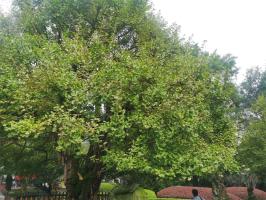Would Planting Trees Increase Global Temperature?
Concerns about global warming and climate change have been growing in recent years, leading many people to explore ways to reduce greenhouse gas emissions and mitigate the effects of climate change. One popular solution that has gained traction is planting trees. But would planting trees actually increase global temperature instead of lowering it?
The Science of Planting Trees and Temperature
Plants use carbon dioxide in the atmosphere to make their own food through photosynthesis, providing an effective way to remove carbon from the air. According to the Intergovernmental Panel on Climate Change (IPCC), afforestation and reforestation could potentially store 0.5 to 3.6 gigatons of carbon dioxide each year, equivalent to about 2 to 15 percent of the current annual global carbon dioxide emissions from human activities. This would make a significant contribution to mitigating climate change.
However, trees also absorb sunlight and heat, which can cause local temperature increases. These temperature increases are generally limited to the tree canopy and the immediate surrounding areas. In addition, trees release water vapor through a process called transpiration, which can cool the surrounding air. The extent to which these two processes balance out depends on a number of factors, including the type of vegetation, the surrounding landscape, and climate conditions.
The Warming Effect of Deforestation
While the warming effect of planting trees is limited, deforestation on a large scale can actually increase global temperature. When trees are cut and burned, the carbon stored in them is released into the atmosphere as carbon dioxide, contributing to greenhouse gas emissions. In addition, forests help regulate the Earth's temperature through their role in the water cycle, as they absorb and release water vapor. Deforestation disrupts this cycle, leading to changes in temperature and precipitation patterns.
The Importance of Sustainable Forest Management
Planting trees can provide important benefits in the fight against climate change, but it is essential to ensure that reforestation efforts are conducted sustainably. This means avoiding planting non-native species that can disrupt local ecosystems, or planting trees in areas where they would not naturally grow. It also means protecting and preserving existing forests from deforestation and forest degradation.
In addition to its role in mitigating climate change, forests also provide a wide range of other benefits, from supporting biodiversity and providing habitat for wildlife to offering recreational opportunities and timber and non-timber forest products. Sustainable forest management involves balancing these various needs and uses of forests to ensure their long-term viability and health.
Conclusion
While planting trees can have a local warming effect, the benefits of afforestation and reforestation in mitigating climate change are significant. It is important to ensure that planting and forest management efforts are conducted sustainably to maximize their benefits and avoid unintended consequences. Protecting and restoring forests can help mitigate the effects of climate change while providing a host of other valuable benefits for people, wildlife, and the planet as a whole.

 how many times do yo...
how many times do yo... how many planted tre...
how many planted tre... how many pine trees ...
how many pine trees ... how many pecan trees...
how many pecan trees... how many plants comp...
how many plants comp... how many plants can ...
how many plants can ... how many plants and ...
how many plants and ... how many pepper plan...
how many pepper plan...






























